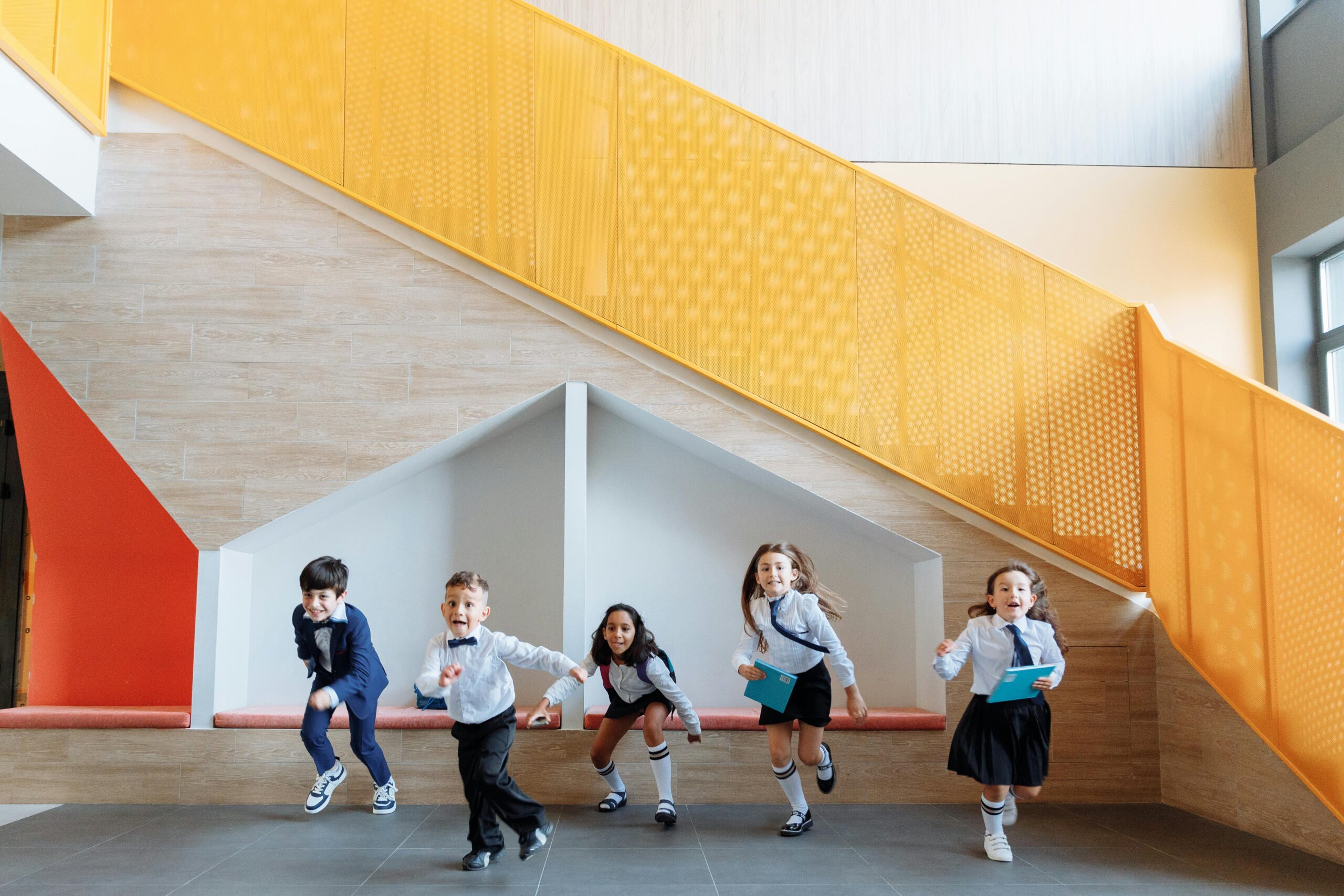The role of Uniforms in Shaping School Culture
Uniforms are more than just a set of clothes students wear—they are a key factor in building a school’s identity. By uniting students under one visual banner, uniforms have the power to influence a school’s culture, reinforce discipline, and foster a sense of unity among students. In this post, we’ll explore how uniforms serve as a vital tool for shaping a school’s values and spirit.
Uniforms and School Identity
Uniforms are a way of visually representing the values and ethos of a school. They symbolize what the institution stands for and reflect the standards it aims to uphold. Just as a corporate logo represents a brand, a school uniform acts as a visual marker of the school’s identity. When students wear their uniforms, they become ambassadors of the school, reflecting its traditions, values, and sense of community.
You can think of uniforms as a kind of “brand identity” for schools. Whether it’s a specific color palette, crest, or unique style, uniforms ensure that students are easily identifiable as part of the same institution. This shared identity can boost school pride and help students develop a stronger connection to their educational environment.
Fostering a Sense of Discipline
Uniforms play a significant role in fostering discipline within a school setting. By wearing a uniform, students are reminded daily of their role as learners and their responsibilities as part of the school community. This routine of getting dressed in a uniform each morning establishes a sense of discipline, which often extends beyond just the dress code.
When students are required to adhere to a uniform policy, it instills a sense of structure and equality. They understand that there are guidelines they must follow, which helps set the tone for their behavior throughout the day. Uniforms minimize distractions related to fashion, encouraging students to focus more on their studies and less on their appearance. By establishing this framework, schools create an environment where academic discipline is prioritized.
Creating Unity Among Students
Uniforms create an immediate sense of unity among students, regardless of their backgrounds, interests, or social status. By eliminating visible socioeconomic differences, uniforms level the playing field and foster a sense of equality within the student body. No one stands out based on the clothes they wear, which can help reduce peer pressure and bullying related to fashion.
This sense of uniformity encourages students to identify with their peers, building a feeling of belonging within the school community. It promotes a team-like atmosphere where students feel they are part of something larger than themselves. The unity that uniforms bring can be particularly beneficial during school events, sports matches, and other group activities, where students are encouraged to work together and represent their school with pride.
Promoting Focus and Academic Excellence
Beyond school culture, uniforms also promote academic focus. When students wear uniforms, they don’t need to spend time thinking about what to wear, freeing up their mental space to concentrate on more important matters, such as their studies. The simplicity of a uniform dress code can reduce distractions and encourage a more serious academic mindset.
By minimizing the focus on individual fashion, uniforms ensure that students are more focused on their education rather than on what they or others are wearing. This shift in focus can have a subtle but significant impact on academic performance, as students are more likely to approach school with a mindset geared toward learning.
Encouraging a Positive School Image
In addition to shaping internal school culture, uniforms also help project a positive image to the outside world. When students wear neat, well-designed uniforms, they reflect positively on their school, creating a lasting impression on parents, visitors, and the broader community. Schools with a strong uniform policy often enjoy a reputation for discipline, excellence, and pride, which can attract prospective students and parents.
A well-maintained uniform sends a message that the school cares about its students’ appearance and the impression they make on others. This attention to detail speaks volumes about the school’s overall dedication to excellence and can play a role in enhancing its public image.
How Uniforms Impact Student Performance

Uniforms have long been a topic of discussion in schools around the world, with educators and parents weighing in on their pros and cons. One fascinating aspect to explore is how uniforms affect student performance. Believe it or not, wearing uniforms can play a role in enhancing students’ concentration, focus, and overall academic success. In this post, we’ll dive into the reasons why uniforms might be more than just a dress code—they could actually be a tool for improving learning outcomes.
Fewer Distractions, More Focus
Imagine this: you’re a student getting ready for school in the morning. Instead of spending time picking out an outfit and worrying about whether it’s trendy enough, you simply put on your uniform. This small change can make a big difference in a student’s mental space. Uniforms eliminate distractions related to fashion choices, allowing students to focus more on their studies.
Research suggests that when students are not preoccupied with their clothing, they are more likely to concentrate on their academic work. The absence of social pressure to “dress to impress” creates a more focused learning environment. When everyone is dressed similarly, there’s less competition to stand out, and students can pay more attention to what really matters: their education.
You can think of uniforms as a way to equalize the playing field. By removing distractions, students can channel their energy into their schoolwork rather than on how they look.
Uniforms Encourage Discipline
One key factor in student success is discipline, and uniforms can help foster that. Wearing a uniform creates a sense of routine and structure, which in turn cultivates discipline. Much like how professionals in the workplace follow dress codes to project a sense of responsibility, students who wear uniforms develop a mindset geared toward discipline and responsibility in their studies.
Studies have shown that when students are in uniform, they are more likely to take their academic roles seriously. A uniform acts as a reminder that school is a place for learning, not for socializing or fashion statements. This subtle psychological shift helps students stay focused and disciplined throughout the school day.
By promoting discipline through uniforms, schools create an environment where students can thrive academically, as they are constantly reminded of the purpose behind their education.
Creating a Sense of Equality
In addition to reducing distractions and fostering discipline, uniforms help to create a sense of equality among students. In many schools, there can be significant differences in the socioeconomic status of students. When there is no uniform policy, wealthier students may feel pressured to wear expensive, fashionable clothes, while others might struggle to keep up. This disparity can lead to feelings of insecurity and competition, ultimately affecting students’ ability to focus in class.
Uniforms level the playing field by ensuring that everyone is dressed the same, regardless of their background. This helps reduce feelings of inequality, boosting student morale and creating a more inclusive atmosphere. When students feel more equal to their peers, they are less likely to experience anxiety related to their appearance, allowing them to focus on their studies.
You might say that uniforms are an “equalizer,” giving every student the same starting point each day, which can have a positive impact on academic performance.
Linking Appearance to Achievement
There’s an old saying: “dress for success.” The idea behind this is that the way you dress can influence your mindset and performance. This concept also applies to students and uniforms. When students wear uniforms, they are dressing for the role of “learner,” which can subconsciously prepare them for a day of academic achievement.
Several studies suggest that how students dress can impact their cognitive performance. By wearing uniforms, students can adopt a mindset that is more focused on learning and less distracted by outside influences. Just as athletes wear specific gear to perform their best, students who wear uniforms might feel more equipped to tackle academic challenges.
Uniforms, in this sense, act as a “mental uniform” that primes students to perform better in the classroom.
Boosting School Spirit and Teamwork
Finally, uniforms can contribute to an overall sense of belonging and school spirit. When students wear the same uniform, they feel like part of a team. This shared identity fosters a sense of community and belonging, which has been shown to improve student engagement and performance. When students feel more connected to their school and peers, they are more likely to be motivated to succeed academically.
Uniforms can also promote teamwork. Much like a sports team, students who wear the same uniform feel like they’re working toward common goals. This sense of unity can be a powerful motivator, encouraging students to support one another and work together to achieve academic success.
Customizing Uniforms to Reflect Your School’s Values

Uniforms are more than just clothing—they’re a visual representation of your school’s identity. When designing uniforms, you have the opportunity to communicate your school’s values and ethos through elements like colors, logos, and materials. Whether you aim to emphasize tradition, inclusivity, or academic excellence, each design choice can reflect what your institution stands for. Here are some tips to help you design uniforms that truly represent your school’s unique values.
Choosing the Right Colors: The Power of Color Psychology
The colors of your school uniforms are one of the most visible ways to express your school’s values. Each color carries its own psychological impact, so it’s important to choose colors that align with your school’s message.
For example, blue is often associated with trust, calmness, and intelligence. It’s a great option for schools that prioritize discipline and academic focus. Green, on the other hand, represents growth and balance—perfect for schools that emphasize environmental consciousness or personal development. Red can evoke passion and energy, making it suitable for schools that value athleticism and enthusiasm.
You want the colors of your uniforms to resonate not only with the students but also with the broader community. A well-chosen color scheme can instill pride and foster a sense of unity among students, teachers, and parents alike.
Logos and Symbols: Embodying School Identity
The logo on your school uniform is like a badge of honor—it should clearly communicate your school’s identity. A well-designed logo doesn’t have to be complex, but it should be meaningful. It can symbolize your school’s history, vision, or core values. For instance, if your school values academic excellence, incorporating elements like books, quills, or even a torch could symbolize the light of knowledge.
Incorporating your school’s motto or mission statement as part of the logo design is another way to reinforce the school’s values. You want your students to feel like ambassadors for your institution, wearing a logo that embodies their role within the school community.
You could also consider involving students in the logo design process, making them feel more connected to the final product. It gives them a sense of ownership and ensures the design resonates with them.
Fabric Choices: Comfort, Durability, and Ethics
While the design and appearance of a uniform are critical, don’t overlook the importance of fabric. The material used can speak volumes about your school’s priorities. For example, if your school values sustainability, you might opt for eco-friendly fabrics like organic cotton or recycled polyester. Not only do these materials have a lower environmental impact, but they can also teach students about the importance of conscious consumption.
Comfort and durability are also key factors. High-quality fabrics that are both breathable and durable show that your school cares about the well-being of its students. It demonstrates a commitment to their comfort, enabling them to focus on learning without distractions from itchy or uncomfortable uniforms.
Incorporating weather-appropriate options, such as lighter materials for summer and warmer ones for winter, further underscores your school’s concern for students’ needs throughout the year.
Incorporating Tradition While Staying Modern
Balancing tradition and modernity is often a challenge when designing uniforms. Many schools have a rich history that they want to honor, but at the same time, they may want to embrace contemporary trends to remain relevant. Striking this balance can help create a uniform that appeals to both older generations and the current student body.
One approach is to keep traditional elements—such as a classic blazer or pleated skirts—while updating colors, patterns, or accessories for a fresh look. For example, some schools may modernize by switching to eco-friendly materials while maintaining a timeless silhouette. This balance ensures that your uniform evolves without losing sight of the school’s heritage.
You can also add subtle modern twists like adjustable fits or unisex designs, which are more inclusive and reflect the evolving values of today’s society. These choices make the uniforms feel contemporary without completely straying from tradition.
Parent Involvement in Uniform Selection

When it comes to finalizing uniforms, you might think it’s a simple decision that can be made by school authorities. But involving parents in the uniform selection process can have a surprisingly positive impact. Schools aren’t just institutions for learning; they’re communities where students, teachers, and parents work together. Seeking feedback from parents when deciding on school uniforms can enhance collaboration and build trust, making parents feel more involved and valued.
Why Parent Feedback Matters
Parents have a unique perspective on what works best for their children. They know their child’s comfort levels, preferences, and any potential issues that might arise from a particular uniform style or fabric. By including them in the selection process, you can ensure the uniforms chosen are both practical and comfortable.
For instance, some fabrics might be too heavy for India’s warmer climates, or some styles may not allow for easy movement during physical activities. When parents contribute their insights, you’re more likely to select uniforms that meet both the school’s aesthetic standards and the students’ needs for comfort. This approach fosters a sense of teamwork and ensures that everyone’s priorities are taken into account.
Building Trust Through Collaboration
Parent involvement in uniform selection can also help build trust between the school and the families it serves. When you give parents a voice in the decision-making process, it sends a message that their opinions matter. This sense of inclusion can make parents more invested in the school and more willing to collaborate on other initiatives.
Schools that prioritize parent feedback tend to have better communication channels and higher levels of parental engagement in general. Whether through surveys, focus groups, or parent-teacher meetings, offering parents a chance to provide feedback builds stronger relationships. It’s not just about choosing a uniform; it’s about creating a culture where parents feel like active participants in their children’s education.
Addressing Concerns and Expectations
Parents often have concerns about the cost, practicality, and design of school uniforms. By involving them in the process, you can address these concerns early on. For example, some parents might worry about the affordability of uniforms, while others may want to ensure that the design reflects the school’s values without being too restrictive or outdated.
Involving parents allows you to gauge what’s most important to them. Maybe they’re more concerned about the ease of cleaning the uniforms or ensuring the outfits allow for flexibility in all weather conditions. Whatever the case, open communication ensures that expectations are managed on both sides, reducing the likelihood of dissatisfaction after the uniforms are finalized.
Enhancing School Identity with Parent Input
Uniforms aren’t just a practical requirement; they’re a key part of your school’s identity. When parents are involved in the selection process, they can offer input on how the uniforms reflect the school’s culture, ethos, and traditions. For example, a parent who attended the school themselves might have a unique perspective on how the uniform has evolved and how it can continue to represent the school’s values in the future.
This feedback is especially valuable in fostering a sense of continuity and pride within the school community. When parents feel like their children are wearing uniforms that represent not just the school but also their values as a family, it creates a stronger connection between home and school life. This emotional connection can translate into greater school spirit and student pride.


